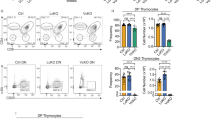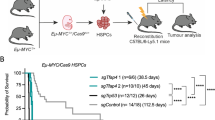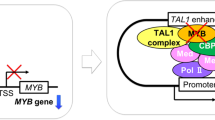Abstract
Activation of the basic helix–loop–helix (bHLH) gene TAL-1 (or SCL) is the most frequent gain-of-function mutation in pediatric T cell acute lymphoblastic leukemia (T-ALL). Similarly, mis-expression of tal-1 in the thymus of transgenic mice results in the development of clonal T cell lymphoblastic leukemia. To determine the mechanism(s) of tal-1-induced leukemogenesis, we created transgenic mice expressing a DNA binding mutant of tal-1. Surprisingly, these mice develop disease, demonstrating that the DNA binding properties of tal-1 are not required to induce leukemia/lymphoma in mice. However, wild type tal-1 and the DNA binding mutant both form stable complexes with E2A proteins. In addition, tal-1 stimulates differentiation of CD8-single positive thymocytes but inhibits the development of CD4-single positive cells: effects also observed in E2A-deficient mice. Our study suggests that the bHLH protein tal-1 contributes to leukemia by interfering with E2A protein function(s).
This is a preview of subscription content, access via your institution
Access options
Subscribe to this journal
Receive 50 print issues and online access
$259.00 per year
only $5.18 per issue
Buy this article
- Purchase on Springer Link
- Instant access to full article PDF
Prices may be subject to local taxes which are calculated during checkout







Similar content being viewed by others
References
Abraham KM, Levin SD, Marth JD, Forbush KA, Perlmutter RM . 1991 Proc. Natl. Acad. Sci. USA 88: 3977–3981
Anderson KP, Crable SC, Lingrel JB . 1998 J. Biol. Chem. 273: 14347–14354
Bain G, Engel I, Robanus-Maandag EC, teRiele HPJ, Voland JR, Sharp L, Chun J, Huey B, Pinkel D, Murre C . 1997 Mol. Cell. Biol. 17: 4782–4791
Bash RO, Hall S, Timmons CF, Crist WM, Amylon M, Smith RG, Baer R . 1995 Blood 86: 666–676
Begley CG, Green AR . 1999 Blood 93: 2760–2770
Brennan TJ, Chakraborty T, Olson EN . 1991 Proc. Natl. Acad. Sci. USA 88: 5675–5679
Cohen-Kaminsky S, Maouche-Chretien L, Vitelli L, Vinit MA, Blanchard L, Yamamoto M, Peshcle C, Romeo PH . 1998 EMBO J. 17: 5151–5160
Condorelli G, Vitelli L, Valtieri M, Marta I, Montesoro E, Lulli V, Baer R, Peschle C . 1995 Blood 86: 164–175
Condorelli GL, Facchiano F, Valtieri M, Proietti E, Vitelli L, Lulli V, Huebner K, Peschle C, Croce CM . 1996 Cancer Res. 56: 5113–5119
Davis RL, Cheng PF, Lassar AB, Weintraub H . 1990 Cell 60: 733–746
Doyle K, Zhang Y, Baer R, Bina M . 1994 J. Biol. Chem. 269: 12099–12105
Early P, Rogers J, Davis M, Calame K, Bond M, Wall R, Hood L . 1980 Cell 20: 313–319
Grimm S, Bauer MKA, Baeuerle PA, Schulze-Osthoff K . 1988 J. Cell. Biol. 134: 13–23
Henthorn P, Kiledjian M, Kadesch T . 1990 Science 247: 467–470
Hsu H, Huang L, Tsan JT, Funk W, Wright WE, Hu JS, Kingston B, Baer R . 1994a Mol. Cell. Biol. 14: 1256–1265
Hsu H, Wadman I, Baer R . 1994b Proc. Natl. Acad. Sci. USA 91: 3181–3185
Hsu HL, Wadman I, Tsan JT, Baer R . 1994c Proc. Natl. Acad. Sci. USA 91: 5947–5951
Hsu HL, Cheng JT, Chen Q, Baer R . 1991 Mol. Cell. Biol. 11: 3037–3042
Hu JS, Olson EN, Kingston RE . 1992 Mol. Cell. Biol. 12: 1031–1042
Huang S, Qui Y, Stein RW, Brandt SJ . 1999 Oncogene 18: 4958–4967
Huang S, Qui Y, Shi Y, Xu Z, Brandt SJ . 2000 EMBO J. 19: 6792–6803
Huang S, Brandt SJ . 2000 Mol. Cell. Biol. 20: 2248–2259
Johnson SE, Wang X, Hardy S, Taparowsky EJ, Konieczny SF . 1996 Mol. Cell. Biol. 16: 1604–1613
Kelliher MA, Seldin D, Leder P . 1996 EMBO J. 15: 5160–5166
Krieg PA, Melton DA . 1987 Methods Enzymol. 155: 397–415
Lassar AB, Davis RL, Wright WE, Kadesch T, Murre C, Voronova A, Baltimore D, Weintraub H . 1991 Cell 66: 305–315
Larson RC, Lavenir I, Larson TA, Baer R, Warren AJ, Wadman I, Nottage K, Rabbitts TH . 1996 EMBO J. 15: 1021–1027
Littlewood T, Evan GI . 1998 Helix-Loop-Helix Transcription Factors Oxford: University Press
Malissen M, Minard K, Mjolsness S, Kronenberg M, Goverman J, Hunkapiller T, Prystowsky MB, Yoshikai Y, Fitch F, Mak TW . 1984 Cell 37: 1101–1110
Murre C, McCaw PS, Baltimore D . 1989 Cell 56: 777–783
Park ST, Sun XH . 1998 J. Biol. Chem. 273: 7030–7037
Porcher C, Swat W, Rockwell K, Fujiwara Y, Alt F, Orkin SH . 1996 Cell 86: 47–57
Porcher CL, EC, Fujiwara Y, Zon LI, Orkin SH . 1999 Development 126: 4603–4615
Prabhu S, Ignatova A, Park ST, Sun XH . 1997 Mol. Cell. Biol. 17: 5888–5896
Sawada S, Littman DR . 1993 Mol. Cell. Biol. 13: 5620–5628
Seldin DC, Leder P . 1995 Science 267: 894–897
Shivdasani RA, Mayer EL, Orkin SH . 1995 Nature 373: 432–434
Taketo M, Schroeder AC, Mobraaten LE, Gunning KB, Hanten G, Fox RR, Roderick TH, Stewart CL, Lilly F, Hansen CT, Overbeek PA . 1991 Proc. Natl. Acad. Sci. USA 88: 2065–2069
Valge-Archer VE, Osada H, Warren AJ, Forster A, Li J, Baer R, Rabbitts TH . 1994 Proc. Natl. Acad. Sci. USA 91: 8617–8621
Visvader JE, Mao X, Fujiwara Y, Hahm K, Orkin SH . 1997 Proc. Natl. Acad. Sci. USA 94: 13707–13712
Visvader JE, Fujiwara Y, Orkin SH . 1998 Genes Dev. 12: 473–479
Voronova AF, Lee F . 1994 Proc. Natl. Acad. Sci. USA 91: 5952–5956
Vyas P, McDevitt MA, Cantor AB, Katz S, Fujiwara Y, Orkin SH . 1999 Development 126: 2799–2811
Wadman I, Li J, Bash RO, Forster A, Rabbitts TH, Baer R . 1994 EMBO J. 13: 4831–4839
Wadman IS, Osada H, Grutz GG, Agulnick AD, Westphal H, Forster A, Rabbitts TH . 1997 EMBO J. 16: 3145–3157
Warren AJ, Colledge WH, Carlton MBL, Evans MJ, Smith AJH, Rabbitts TH . 1994 Cell 78: 45–57
Zhuang Y, Cheng P, Weintraub H . 1996 Mol. Cell. Biol. 16: 2898–2905
Acknowledgements
The authors would like to acknowledge the expert technical assistance of the University of Massachusetts Medical School Transgenic Mouse Core Facility. M Kelliher is a recipient of a Sidney Kimmel Cancer Scholar Award.
Author information
Authors and Affiliations
Corresponding author
Rights and permissions
About this article
Cite this article
O'Neil, J., Billa, M., Oikemus, S. et al. The DNA binding activity of TAL-1 is not required to induce leukemia/lymphoma in mice. Oncogene 20, 3897–3905 (2001). https://doi.org/10.1038/sj.onc.1204519
Received:
Revised:
Accepted:
Published:
Issue Date:
DOI: https://doi.org/10.1038/sj.onc.1204519
Keywords
This article is cited by
-
Transcription of human β-galactoside α2,6-sialyltransferase (hST6Gal I) is downregulated by curcumin through AMPK signaling in human colon carcinoma HCT116 cells
Genes & Genomics (2023)
-
Integrative network analysis reveals USP7 haploinsufficiency inhibits E-protein activity in pediatric T-lineage acute lymphoblastic leukemia (T-ALL)
Scientific Reports (2021)
-
Oncogenic transcriptional program driven by TAL1 in T-cell acute lymphoblastic leukemia
International Journal of Hematology (2019)
-
Identification of novel lncRNAs regulated by the TAL1 complex in T-cell acute lymphoblastic leukemia
Leukemia (2018)
-
Stem Cell Leukemia: how a TALented actor can go awry on the hematopoietic stage
Leukemia (2016)



